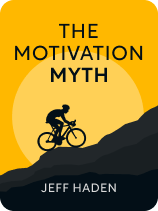

This article is an excerpt from the Shortform book guide to "The Motivation Myth" by Jeff Haden. Shortform has the world's best summaries and analyses of books you should be reading.
Like this article? Sign up for a free trial here.
How do you know when you’ve finally “made it?” What do you do next if you find the success you’ve been chasing?
When many people hit success, they don’t even know they have it. That’s because there’s not one solid definition of success—everyone measures success differently, and you have to find your own meaning.
Check out how to measure success, according to The Motivation Myth by Jeff Haden.
Creating Your Own Idea of Success
Knowing how to measure success is crucial to living a balanced, healthy life. Haden offers guidelines on how to realistically measure success, why you should aim for it in multiple parts of your life, and why personal goals should be just as important, if not more important, than professional ones.
He begins by pointing out that any goal you pursue comes with a cost. Chasing professional goals will often mean neglecting the rest of your life while devoting yourself to personal goals will usually mean not making the most of your career. Therefore, Haden says it’s unrealistic to believe that you can maximize both. Instead, you need to be honest with yourself about how you define “good enough.” If you wish to be among the top 1% in any field, whether that’s sales, photography, or weightlifting, it will take a lifetime of single-minded dedication. However, being counted in the top 10% is eminently rewarding and much more achievable.
| What Does “Success” Really Mean? Despite all the literature on how to achieve success in life, a true definition of personal success is elusive. In general, authors agree with Haden that individual definitions of success will vary, and instead, they focus on the characteristics of success. In The Success Principles, Canfield links personal success to identifying and following your purpose in life. In The 10X Rule, Grant Cardone explains that success isn’t something with a limited supply, but instead, it’s something you can work for and achieve again and again. Philosophers and wellness experts take a different view. In Happy, Derren Brown argues that chasing after achievements will keep you trapped on a neverending treadmill of desire, brief rewards, and disappointment. In The Happiness Advantage, Shawn Achor also denies that success leads to happiness but says that instead, the reverse is true—finding happiness is what leads you to success. In The Book of Joy, the Dalai Lama and Archbishop Desmond Tutu discount any connection between striving for accomplishments and finding joy in life, instead arguing that looking for external sources of fulfillment is inherently detrimental. On the spectrum between these differing opinions as to what degree success leads to personal fulfillment, Haden’s approach to qualifying success may be seen as more measured than the extremes on either end. |
With that in mind, Haden lays out the following rules:
1. Before setting out on an ambitious project, make sure that you’re mentally, physically, and financially sound. If you can’t meet your basic human needs of food, shelter, community, and relationships, then that’s what you have to take care of first.
2. When you set a long-term goal, choose one that fulfills you in more than one aspect of your life. It’s easy to give up on goals that only serve one facet of yourself, such as your job or your health. A goal that brings together more than one ambition—such as becoming a freelance writer to further your career and your creative drive—will be more closely tied to your identity and less likely to get dropped by the wayside.
3. Define your goal in a way that’s quantifiable. Your ambition can start as a nebulous dream, but as you set your course it should grow more concrete. Quantifiable goals let you know if you’ve achieved them—you’ll know for certain when you’ve finished hiking the Appalachian Trail, just as you’ll know you’ve scored an acting role in the latest television sitcom. Solid goals are based on more than just a feeling.
| Goals for a Balanced Life The path to fulfillment that Haden describes is a relatively recent human invention. In The One Thing, Gary Keller recounts that for most of human history, your work was your life, and all your daily activities were governed by the struggle to meet your basic needs. Once technology started freeing people from the endless daily drudgery of living, people started to seek the perfect balance between work, family, leisure, and achievement. In Lean In, Sheryl Sandberg argues that some degree of balance is possible, but realistically it’ll never be perfect and will require making compromises in various aspects of your life. In Designing Your Life, Bill Burnett and Dave Evans offer a practical approach to getting your life in order before moving on to greater ambitions. The first step is a self-assessment to determine where you stand in terms of physical and mental health, your career, and overall happiness. Once you’ve done that, you can identify what areas need improvement and set goals to bring your life into alignment. Finally, in First Things First, Stephen R. Covey makes the point that achieving a goal you’ve worked long and hard for can actually be painful—if it was the wrong goal all along. According to Covey, it’s not enough that long-term goals be measurable and touch on various aspects of your life, as Haden suggests. They should also tap into the deeply human traits of creativity, willpower, and morality, as well as the self-awareness to change your ambitions if life and circumstances demand it. |
Your Goal Isn’t the End
Haden makes clear that any goal you set for yourself isn’t going to consume the rest of your life. Because of that, you should expect to have multiple goals—just not all at once. Instead, once you’ve achieved success as you define it in relation to one specific objective, you should set your sights on the next one, and the next. Think about musicians who branch into acting, actors who become directors, and directors who write books. Consider athletes who open up restaurant chains, or restaurateurs who become travel writers. These are only the most well-known examples, but if you truly wish to have a well-rounded life, you should be open to following your dreams in however many directions they take you.
(Shortform note: Haden is basically arguing in favor of becoming a polymath—someone who’s well-versed in many skills and fields of knowledge. The most famous example of a polymath was Leonardo da Vinci, who was skilled as a scientist, an engineer, and an artist. As opposed to specialists with narrow expertise, people with skills in a variety of areas can combine them in innovative ways peculiar to their own unique sets of knowledge. Adaptability, flexibility, and having a wide range of interests are going to become more and more valuable, both for the workforce and for mental health, as people live longer lives in the future.)
Most of all, when you begin a cycle of improvement, repetition, and self-motivation, you need to be sure that the goal you’ve picked is something you’ll enjoy. Also, your goals don’t have to be aspirations that send your life in a whole new direction—they might simply be new skills to add to what you already do. Haden suggests that the most fulfilling goals are things you’ll regret if you don’t ever try. More likely than not, those goals won’t have anything to do with your profession, but they’ll be no less rewarding for having been followed.
However, nothing’s ever as rewarding as a dream. So define what you want, build a program to achieve it, create a positive cycle of reinforcement, persevere through the hard times, and enjoy every win along the way.
(Shortform note: By arguing that you should pursue success in multiple fields that you’re passionate about, Haden implies that happiness and fulfillment should be your objectives, and not just success for its own sake. But is happiness something you can achieve by design? In The Happiness Project, Gretchen Rubin says it is. She set herself the year-long goal of improving her life in several key areas, including work, relationships, parenting, and play. At the end of her experiment, she concluded that happiness is a goal you can work for, agreeing with Haden that it’s the work that counts and that you don’t need to wait around for motivation.)

———End of Preview———
Like what you just read? Read the rest of the world's best book summary and analysis of Jeff Haden's "The Motivation Myth" at Shortform.
Here's what you'll find in our full The Motivation Myth summary:
- Why you should stop waiting for motivation to hit and instead, make your own
- How to create a cycle of positive reinforcement to boost your motivation
- How to develop resilience to get through times of struggle






